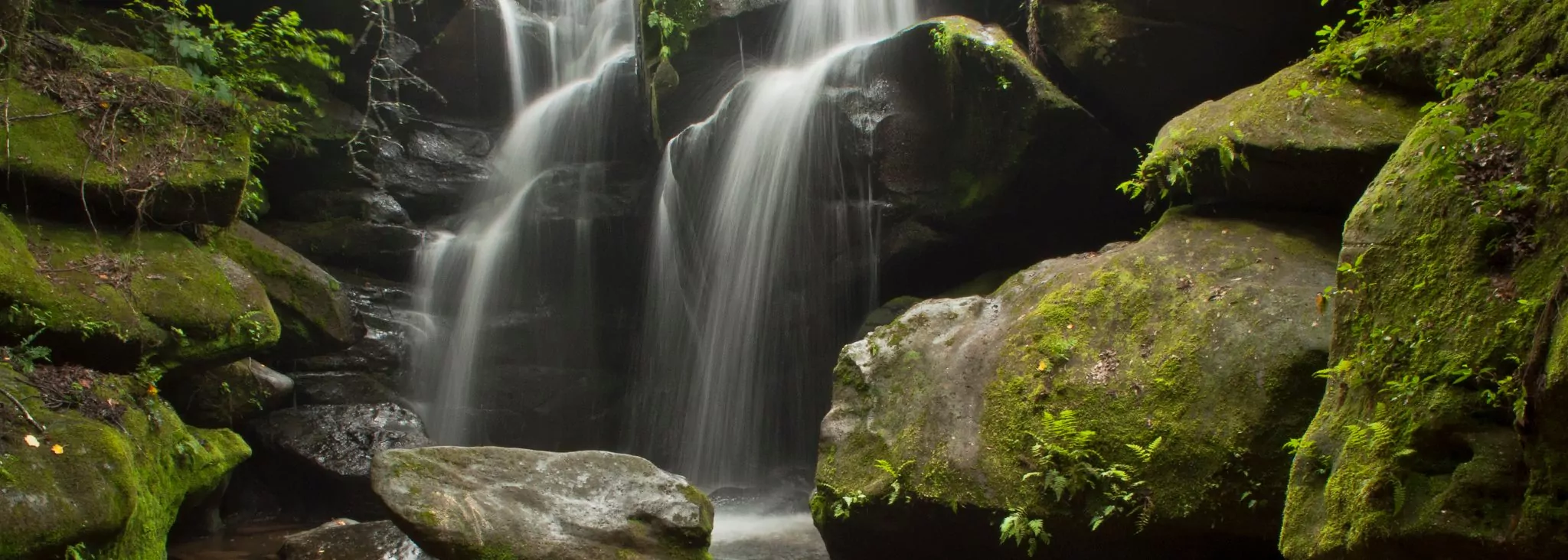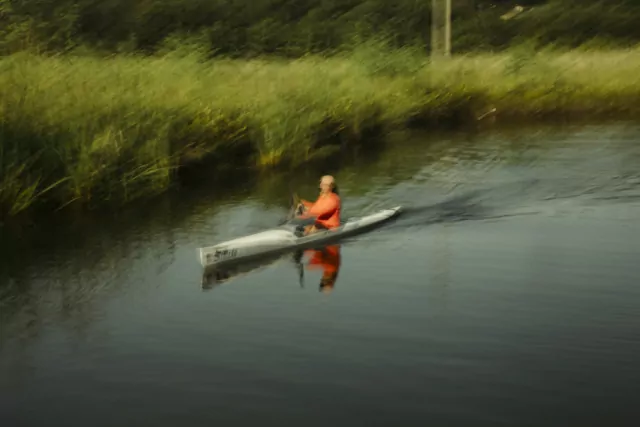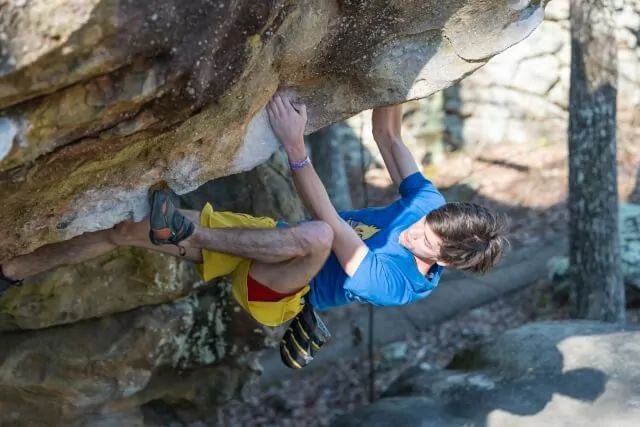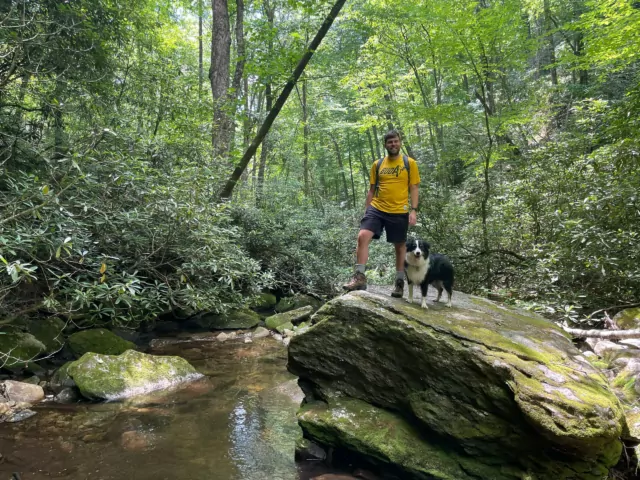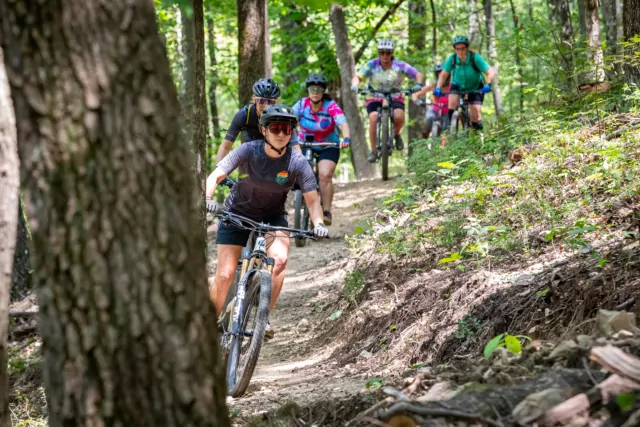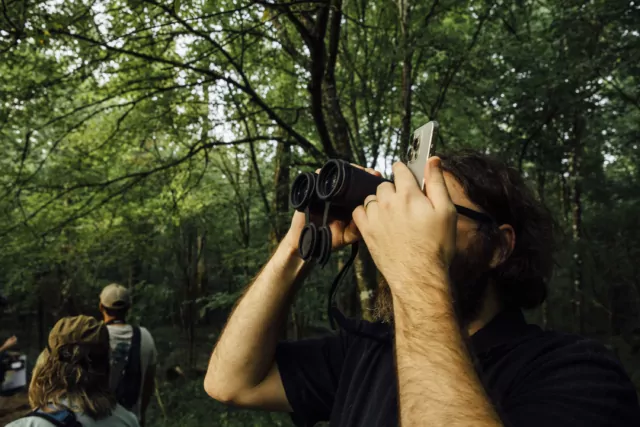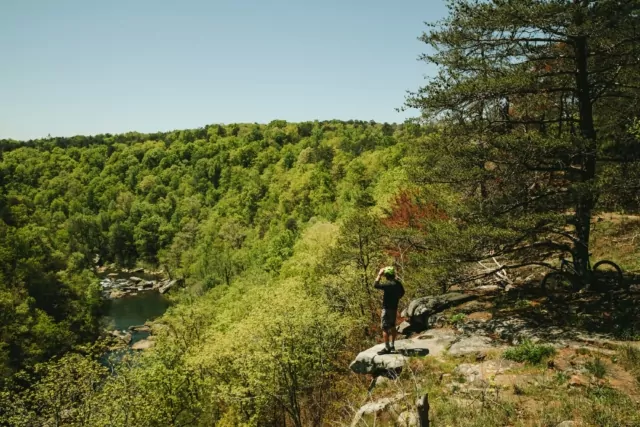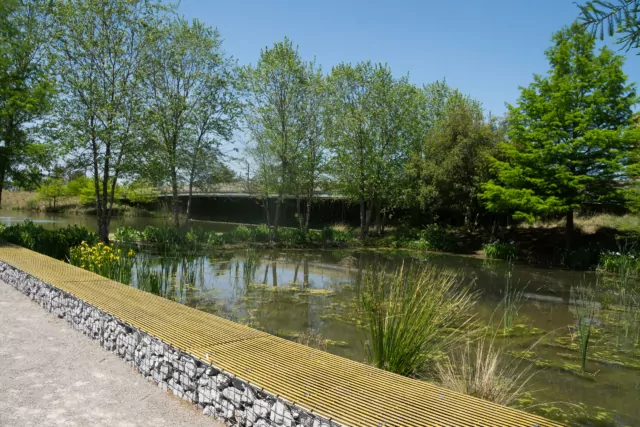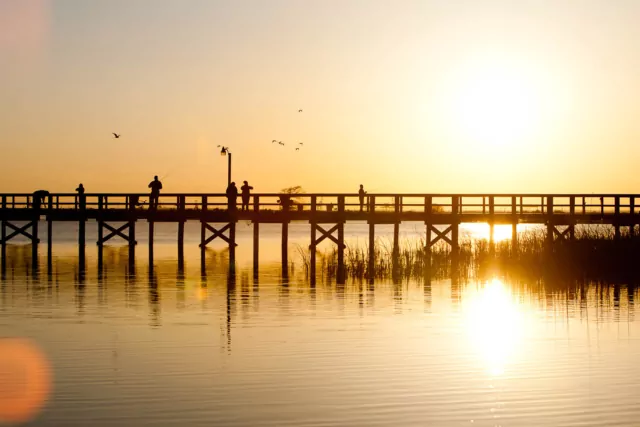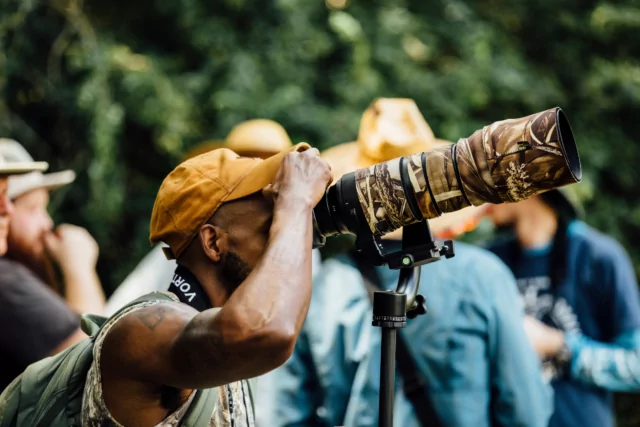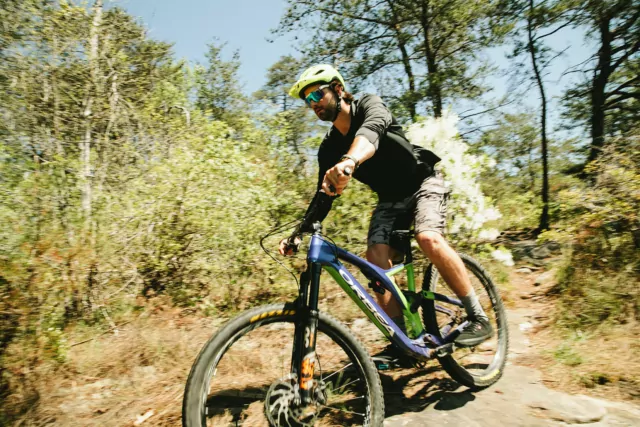It’s dark as we descend the wooden staircase, but by the time we take our first steps onto the canyon floor, darkness has taken on a whole new meaning.
Most of our group brandished iPhone flashlights on the journey down, but now that we’ve reached our destination, our guide instructs us to switch them off. When the last goes out, everything is plunged into velvety black.
The waning moon provides little by way of natural light, but what little peeks through the dense canopy reveals the spidery silhouettes of ancient ferns, moss-covered boulders, rocky overhangs and a boardwalk guiding us to the reason we’re all here—thousands of tiny bioluminescent “glowworms” that are native to this little-known nature preserve in north Alabama. In a state where natural hidden gems lurk in every corner, Dismals Canyon and its famous dismalites might just be the crown jewel.
Rare Breed
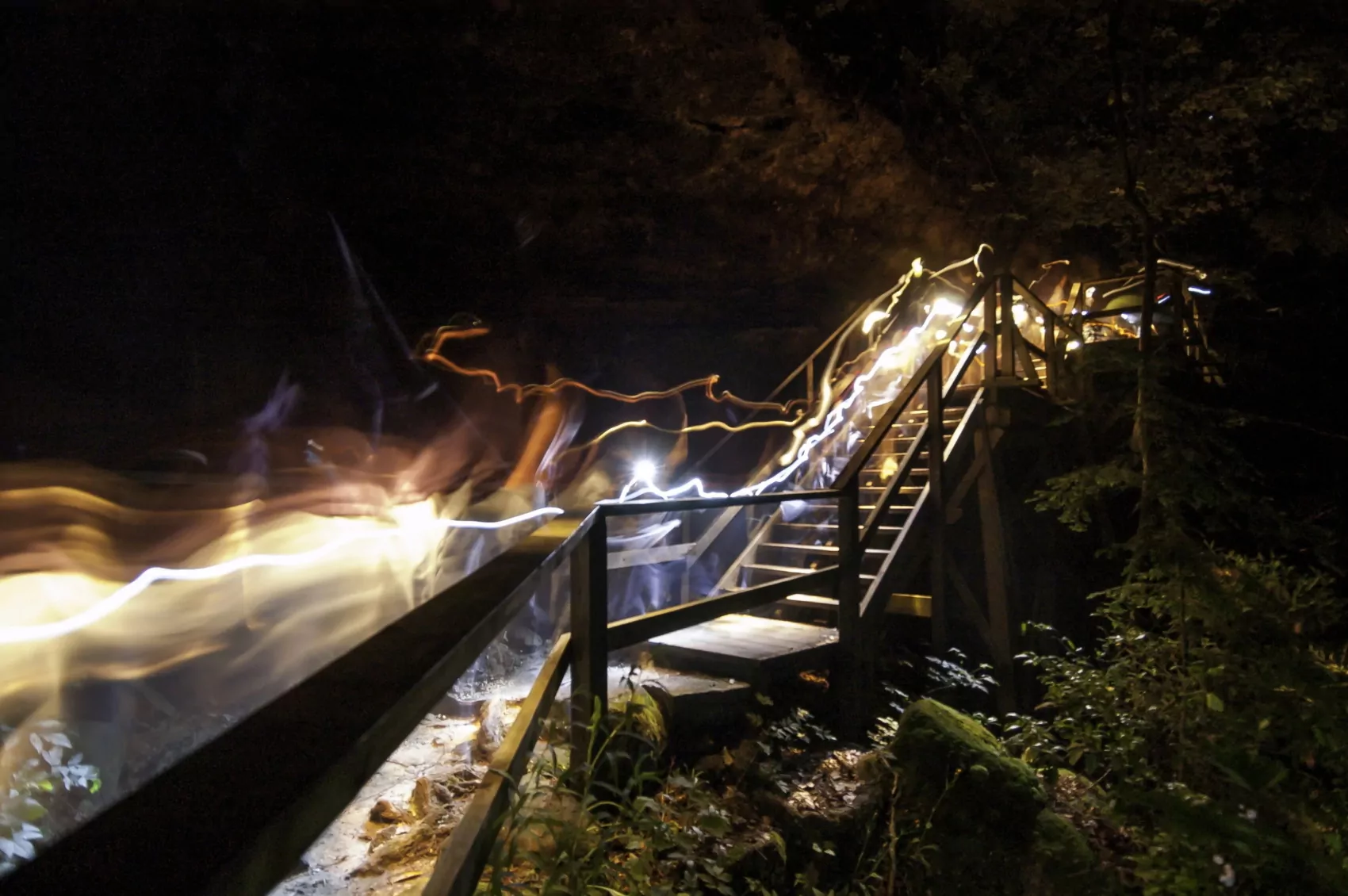
Scientists have dubbed them Orfelia fultoni, but Alabamians prefer the term dismalites, named for their natural habitat in Dismals Canyon. You may hear them described as glowworms, but that classification is a bit of a misnomer. Dismalites are actually the larvae of a species of fungal gnat. When it’s dark, they emit a bioluminescent blue-green light that attracts small insects.
These insects get stuck in their webs and become dinner. The darker the surroundings, the easier it is to see the dismalites’ ethereal glow, which is why we’re especially lucky the moon is nothing more than a sliver on the night we visit.
No larger than the end of a pencil, the tiny critters are exceedingly rare. While they’re endemic to North America, living primarily in the Appalachian Mountains and Cumberland Plateau, Dismals Canyon is the only place where they reside in such large numbers. A similar species can be found in certain caves in New Zealand and Australia, but those shine only from their tails. The ones at Dismals Canyon glow from both their tails and their heads, emitting a powerful glow that photos really can’t do justice. They are also said to have the bluest glow of any bioluminescent insect.
“It’s beautiful every time,” says Kevin Cheek, chief operating officer for Dismals Canyon. “I smile when I see the first one, and I smile through the entire tour.”
Dismalites aren’t just rare in terms of where they can be found, they’re also rare for when they can be found. Their elusive light show can be seen on two occasions each year—once in the spring from late April through May and again during the fall from the end of September through October.
Spring is the peak, when you can see thousands of dismalites twinkling from the canyon’s mossy rock walls. Fall brings smaller numbers (hundreds of dismalites instead of thousands), but its own magic too. Glimmering firefly larvae join the party, and the freshly fallen giant magnolia macrophylla leaves create an extra special atmosphere.
“The way the moonlight shines on [the magnolia leaves], they almost glow,” Cheek says. “So, it’s beautiful in the fall too.”
A Protected Preserve

While the dismalites are a buzzy draw for visitors, Dismals Canyon is just as deserving of a visit during daylight hours. The 85-acre natural conservatory is a wonderland with fairytale-like scenes. The sunken forest is populated by massive moss-covered boulders, old-growth timber, waterfalls, grottos and rock shelters. It’s all covered by a dense canopy that adds an air of mysticism and makes exploring the preserve ten times more manageable in the heat of the Alabama summer.
The combination of humidity (thanks to Dismals Branch, a stream that flows through the heart of the canyon) and cool (thanks to the tree shade) provides the perfect environment for dismalites. The mossy rock walls and overhangs create the ideal environment for dismalites to spin their webs. The exceedingly dark conditions make their bioluminescent bait even more effective.
The labyrinth-like collection of caverns, slot canyons and grottos was created by geological events that happened 300 million years ago during the Paleozoic Era. Draining waters from a melted glacier carved a primeval swamp into the intricate canyon system we enjoy today. Over its long history, Dismals Canyon has been inhabited by Paleoamericans, then Chickasaw and Cherokee Native Americans. Later, Scotch-Irish settlers moved in and named the canyon after a spot back home in Scotland called Dismals.
The National Park Service designated Dismals Canyon as a National Natural Landmark in 1974, but the conservatory remains privately owned and operated. In fact, it was open to the public for nearly two decades before earning the designation.
Says Travis Langen, executive director of the Gulf Coast Center for Ecotourism and Sustainability, “Places like Dismal Canyon are important because they show how conservation and careful resource management are good for business. They demonstrate how the private sector can be good stewards of the environment as they provide opportunities for people to explore nature in a way that is carefully managed and respectful to wildlife and natural features. Places like Dismal Canyon remind us that there are so many amazing places to discover and explore throughout Alabama.”
Cheek, who grew up “just across the road” in Opal says his father helped open the park when he was only 10. He grew up visiting the preserve and has been working there on and off since 1999. Last year, when he returned as chief operations operator, it all came full circle.
“For the first time in my life, I feel like I have purpose,” he says of his new role. “I want to preserve this for future generations so they can enjoy it.”
A mix of wooden footbridges, dirt paths and stepping stones creates a winding path through the bottom of the gorge. The 1.5-mile trail is easy to traverse and equally rewarding to explore. Look out for landmarks like Pulpit Rock, which offers a panoramic view of the canyon below; the Temple Cave, a bluff shelter that was once home to Paleo Native Americans; Fat Man’s Misery, a 16-inch-wide squeeze between boulders; and two waterfalls. Don’t miss the Champion Tree, a 138-foot tall Eastern Hemlock that’s the largest of its species in the state.
Sky Full of Stars
On a dismalite walk, two of the most spectacular spots to see bookend the tour. The Grotto, a boardwalked path where boulders stretch high into the sky, gives a first taste of the shimmering show to come.
“I see one!” exclaimed a school-aged child on our trip. Everyone followed her outstretched finger to see our first dismalite twinkling on the rock wall about a foot above her head. Everyone crowded around to observe the two distinct glow points on its body before realizing that the critter had friends and family all around. The boulders on both sides of the boardwalk were littered with bright spots starting below eye level and climbing all the way up into the night sky. It was hard to tell where the dismalites ended and the stars began.
“It looks like you’re walking through a planetarium,” Cheek says. “They’re all around you like little planets.”
After such a stunning start, we already had our expectations blown out of the water, but Dismals Canyon had one more surprise in store. Near the end of the trail, Witches Cavern is the grand finale that punctuates a truly unforgettable experience. This is the place where the oohs and aahs once again become audible.
Without a guide, you’d probably miss it. Cheek describes it as a “Harry Potter wall” because the entrance is obscured by a sheer rock face. Your nose nearly touches stone before the path reveals itself and you can slip into the narrow maze of moss- and fern-covered boulders.
“If you don’t realize, you’ll turn around and leave and not even go through there,” he says. “You kind of walk through the rock. It’s super cool.”
Cheek’s assessment is an apt one. The speakeasy-esque entrance adds an air of anticipation as we round the corner for the big reveal. Once we’ve safely navigated to the first landing, we find ourselves face to face with a litany of dismalites. Close enough to touch (though it’s against the rules to do so), our vicinity to these little wonders brings an indescribable rush. A few minutes later as we make our way out of the canyon, we’re struck again by our luck to have seen this natural phenomenon and the astounding fact that it’s right in our own backyard.
“I saw some article the other day about how Alabama is one of the places tourists don’t go,” Cheek says. “I think it’s just not being reported because I have people from all over the world. I always ask ‘What brought you to America? What are you here to see?’ And for them to look at you and smile and say, ‘I come to see Dismals Canyon’—that’s amazing.”
Planning Your Trip

Getting There
Dismals Canyon is located in North Alabama, about 80 miles west of Huntsville and 85 miles north of Birmingham. It takes about an hour and a half to get there from either city.
Make a Reservation
Guided night tours run twice a year, from April through July and again from September through October. Tours take place on Friday and Saturday nights with a maximum of 20 people per group and five tours taking place per weekend. This year’s fall tours will start on September 20. The 45-minute tours depart at 7 p.m., 8 p.m., and 9 p.m. Reservations are taken for the following weekend beginning on the Sunday before. Call 205-993-4559.
Cheek takes all the reservations by phone and says though it can take some persistence since there are often thousands competing for the 100 weekend spots, it’s more than worth it.
“It’s very personable when you come here,” he says. “You either get me or the busy signal, but we talk to you just like you’re an old friend.”
Night tour tickets are $25 for adults and $18.75 for children under 12.
Where to Stay
Dismals Canyon operates two guest cottages available for overnight stays, but they are currently closed for renovations. Hotel lodging can be found in the neighboring towns of Russellville and Hamilton.
More to Explore
If you don’t secure a night tour (or even if you do), make plans to see Dismals Canyon in the daylight too. Entrance to take a self-guided tour of the canyon is $20 on Mondays through Thursdays and $26 on Fridays through Sundays. Combination day and night tour admission is $43.50.
Start or end your visit with a stroll around Dismals Canyon’s Old Country Store, where you can find everything from T-shirts and souvenirs to old-fashioned candy and Native American wares. The Dismals Canyon Soda Fountain, with outdoor tables overlooking the canyon floor, is the perfect place to refuel on your way out. The menu features classic sandwiches like homemade chicken salad, tuna salad and pimento cheese, as well as old-fashioned soda fountain treats like malts, shakes, floats and sundaes.
